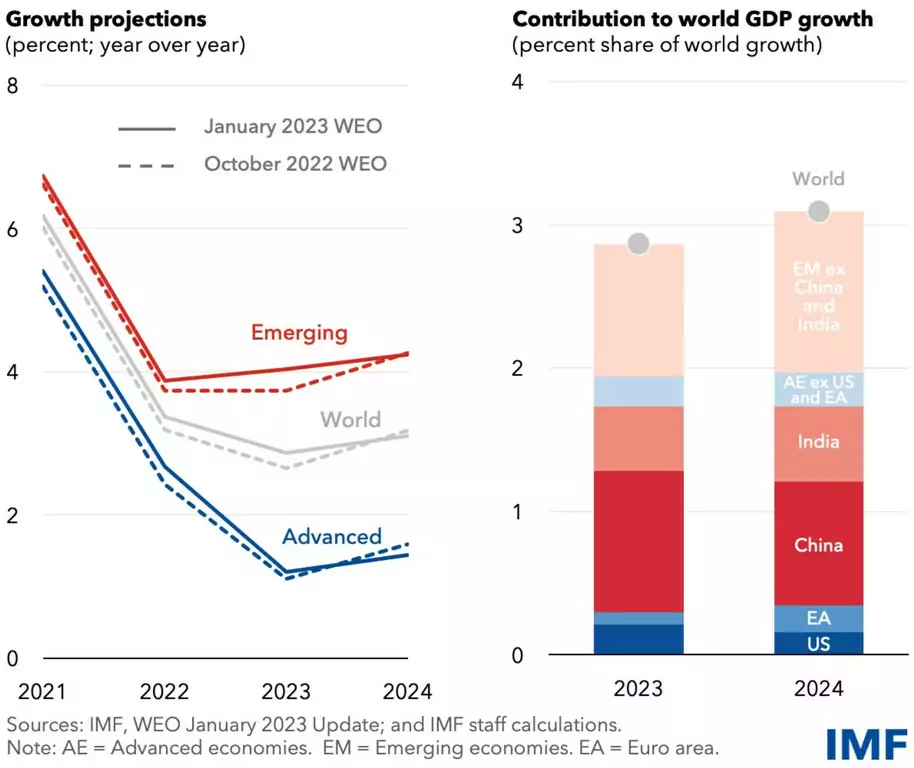The global economy is set to slow down this year before bouncing back in 2024, a senior official with the International Monetary Fund (IMF) has said, citing China’s sudden re-opening following the end of its “zero-COVID” policy, and a mild winter, in Europe as factors.
The IMF estimates growth at 2.9 per cent this year, falling from 3.4 per cent in 2022 and reaching 3.1 per cent in 2024.
Global growth is projected to fall from an estimated 3.4% in 2022 to 2.9% in 2023, before rising to 3.1% in 2024. Watch IMF Chief Economist @pogourinchas summarize the key findings of our latest World Economic Outlook Update: https://t.co/4ifKc9qi4j #WEO https://t.co/HOCfdAl2mz
IMFNews
This represents a slight adjustment, 0.2 percentage points, from its World Economic Outlook (WEO) forecast in October.
Possible ‘turning point’
“Growth will remain weak by historical standards, as the fight against inflation and Russia’s war in Ukraine weigh on activity,” said Pierre-Olivier Gourinchas, the Fund’s Chief Economist, in projections published on Monday.
He added that this outlook “could represent a turning point, with growth bottoming out and inflation declining.”
Resilience and improvement
Economic growth proved surprisingly resilient in the third quarter of 2022, the IMF said.
The period was characterized by strong labour markets, robust household consumption and business investment, as well as better-than-expected adaptation to the energy crisis in Europe.
Inflation also improved, though core inflation, which excludes volatile energy and food prices, has yet to peak in many countries.
Relief for developing economies
China’s re-opening paves the path for a rapid rebound in activity, while global financial conditions have improved as inflation pressures reduce.
“This, and a weakening of the US dollar from its November high, provided some modest relief to emerging and developing countries,” said Mr. Gourinchas.
The slowdown will be more pronounced for their wealthier counterparts, as nine out of 10 advanced economies are likely to decelerate.
These countries should see a decline from 2.7 per cent last year to 1.2 per cent this year, and 1.4 per cent in 2024.

Interest-rate impacts
In the United States, growth will slow to 1.4 per cent in 2023 due to the impact of Federal Reserve interest-rate hikes on the economy.
Conditions in the Eurozone are more challenging despite signs of resilience to the energy crisis, a mild winter and generous fiscal support.
“With the European Central Bank tightening monetary policy, and a negative terms-of-trade shock – due to the increase in the price of its imported energy – we expect growth to bottom out at 0.7 per cent this year,” said Mr. Gourinchas.
Meanwhile, emerging market and developing markets are expected to see a modest rise in growth as they have already “bottomed out”, going from 4.0 per cent this year to 4.2 per cent in 2024.
China should see growth rebounding to 5.2 per cent this year, now the economy has re-opened following COVID-19 outbreaks and central government restrictions.
The country, together with India, will account for half of global growth this year, compared to just a tenth for the US and Euro area combined.
As an independent media platform, we do not take advertisements from governments and corporate houses. It is you, our readers, who have supported us on our journey to do honest and unbiased journalism. Please contribute, so that we can continue to do the same in future.
